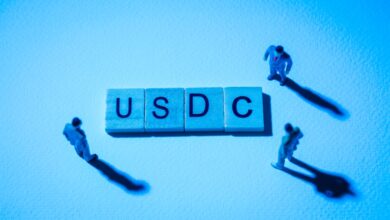Nested Exchanges – What Are They And Why Should You Avoid Signing Up With Them?

The financial services come with regulations and some policies binding them either globally or based on jurisdictions. And this can be very limiting in expressing the full possibilities of the sector. These imposed limitations are due to the fear from the government that people will abuse the sector for criminal activities ranging from terrorism financing to money laundering. However, there have been different attempts to boycott these challenges, one of which led to the birth of cryptocurrency and blockchain.
These new developments aim at giving the global populace a more flexible interaction with the available financial services while creating new ones. One of the common issues is cross-border money transfer which has caused a dependence on some particular currencies in a volume that is regulated.
Beyond, another idea behind crypto is giving the unbanked population access to financial services, especially those who are limited because of their inability to meet certain requirements based on the policies guiding financial operations in the jurisdiction.
Before diving into the meaning of nesting and nested exchanges, it is much more needful to consider the different ways to trade cryptocurrencies and how the need for an exchange entered the picture. This will help you gain a full perspective and understanding of the operations of crypto exchanges and other related entities in the crypto space.
Different Ways to Trade Cryptocurrencies
1. Price Speculation
The birth of cryptocurrencies came with some confusion – many of which are unsolved till today. One of them is the question of whether to name crypto security or a commodity. Some schools of thought call it a virtual commodity – just like you can buy physical gold, while some said it is just security you can buy into.
Either way, one of the common ways people who believe cryptocurrencies are securities trade them is by speculating the prices using CFDs. Just it is with forex, stocks, and indices.
To explain better, CFDs are a kind of contract that exists between a broker and an investor, which allows them to trade or invest in a particular asset without directly opening a position in that particular market. Basically, the broker replicates the same market conditions based on an agreement with the trader, and they also settle the difference between themselves at the closure of the position.
Generally, there are some advantages this kind of trading holds compared to direct trading. Among these advantages are leveraged trading, access to the international markets, and the ability to open a short position for some assets that are not traditionally compatible with such an option.
However, the advantages of CFD trading compared with the other kind of trading is the ability to access leveraged trading and also the ability to open short positions.
This is a way to gain exposure to the crypto market without actually buying the cryptocurrency or worrying about owning a wallet to keep the assets.
2. Spot Trading
This is the traditional and the seeming conventional way to access the crypto market. With this approach to crypto trading, you will have direct exposure to the asset and you will also be concerned about the responsibility of owning a crypto wallet, including the security.
Basically, spot trading is a kind of trading where you buy and hold the crypto assets in your wallet while you wait for the value to increase. This means you are holding on to a portion of the total supply of the asset.
To engage this king of trading, there are two methods of purchasing the crypto asset. The first method is the peer-to-peer (P2P) method where you will look for another crypto trader who is willing to exchange the crypto asset you want to buy for either fiat currency or another crypto asset depending on your mutual agreement.
As a matter of fact, this is one of the motivations behind the creation of the first cryptocurrency – Bitcoin, as the creator, Satoshi Nakamoto, considered that cryptocurrencies could help eliminate third parties in every financial transaction. This method will involve the creation of a crypto wallet.
However, another way to purchase a crypto asset is through crypto exchanges. All you just have to do is to create an account with the exchange, which will require that you meet their requirements.
For most crypto exchanges, because of government policies, the process of opening a functional account can be longer than expected. A common slowdown is the KYC (know your customer), which is mandated for every centralized exchange to carry out for their users in fulfillment of the anti-money laundering and anti-terrorism financing agenda.
However, there is a possibility that some crypto exchanges could not extend their services to some locations because of their inability to meet the requirements to get an operation license in that jurisdiction. In an attempt to still provide services for their customers in these regions, most exchanges result in what is called Nesting.
In the next section, this guide will introduce the concept of nesting in the crypto space and also highlight the reasons why you should avoid them as much as how to identify them.
Introduction to Nesting
In the crypto space, one of your priorities is security. And as a result, when you are considering buying or selling any crypto asset, it is advised and recommended that you do so with a trusted website. As mentioned earlier, when you are creating an account with the crypto exchange, one of their requirements for them, to be committed to your safety is to pass the AML and KYC checks. However, in an attempt to bypass these checks, some users choose the exchanges that offer little or no checks when they are signing up. Some even allow for instant trading on their website.
Some of these exchanges offering shortcuts can actually be decentralized exchanges, but others could be nested exchanges that are often used to handle laundered and stolen funds. With these kinds of exchanges, your funds are not safe.
The essence of this guide is to help your keep your crypto asset safe and secure by educating you about nested exchanges; what they are, what they do, and how you can identify them.
What is Nesting?
This is a phenomenon that existed with financial institutions where a particular financial service provider will create an account with another financial service provider to use their services. The purpose of this bridge created by the nested account holder is to use the services of the new financial service provider to serve their customers around that region. There are many reasons why this happens, but one of the major reasons is the location barrier.
Here is an illustration; a bank in country X might decide to open a nested account with another bank in country Y just to extend their banking services and ecosystem to their customers in country Y when though they are not physically present and established in the country Y.
Now imagine a customer who needed to transfer money to another bank account in New Zealand while he is in the United States. Apparently, his bank in the United States cannot directly offer this service, but instead, they will use their bank account with a bank in New Zealand (a nested account) to execute that transaction. This means that in the real sense the transaction was handled by the bank in New Zealand, not the one in the United States.
The implication of nesting in the financial industry means that the correspondent bank is indirectly serving customers that don’t know since they have not done any KYC check on them, but it is built on trust for the bank holding the nested account.
What then is a Nested Crypto Exchange?
Just like it is in the traditional financial system, so it is in the crypto space. The idea of nesting in the crypto space is quite simple. A person or entity creates an account with a regulated crypto exchange with the sole aim of using that account to offer crypto trading services to a third-party community through the nested account.
These crypto exchanges are often time called instant exchanges and they often own accounts with different crypto exchanges across the crypto space. Some of these exchanges might ask for a means of identification for KYC checks, while some require little or no identification whatsoever to use their services. This makes them the best option for fraudsters, ransomers, and scammers. In fact, some nested exchanges even allow people to buy and sell crypto in person while they pay them in cash.
What is the Danger of Nesting?
Looking at this from the perspective of the traditional financial, the biggest danger attached to nesting is the risk of money laundering. The correspondent bank with whom a nested account with opened only deals with the nested account holder, and in most cases, they are not aware of the individuals they are dealing with. For what it is worth, nesting requires a more diligent and enhanced check from the underlying banks on their customers.
Any fault in the process can lead to sanctions being placed on individuals, entities, or entire countries, of which they can eventually be blacklisted. This is because failure to carry out a diligent check can lead to the nested account holder and account provider supporting illegal financial activities like money laundering.
However, because the framework of regulations in the crypto space is still under development largely in most countries and even globally, it is quite easier for nested exchanges to operate freely under the radar. In fact, a nested exchange could have an account with a regulated crypto exchange with them knowing easily.
What are the Dangers of Nesting in the Crypto Space?
Every time you use a nested crypto exchange, the risk exposure is not just on the centralized crypto exchanges, but on you and your funds. In this section of the guide, we will consider several reasons why using a nested exchange can be dangerous.
1. The safety of your deposits cannot be as guaranteed as it is with regulated crypto exchanges.
2. You might indirectly be supporting criminal activities like terrorism and crime funding.
3. Sooner or later, regulatory activities might lead to the permanent closure of the nested crypto exchange, which can result in the loss of funds and crypto for you.
4. However, if it is proven that you are directly working with the nested exchanges to execute criminal and illicit activities, you could face legal repercussions from the law enforcement agencies.
With all being said, the best way to avoid all these dangers is to avoid nested crypto exchanges. The truth is they are not obvious, which might make spotting them very tricky. In the following sections, you will be armed with tips that will help you protect yourself from the nested crypto exchanges.
What is the Difference between a Decentralized Exchange and a Nested Exchange?
At first impression, a decentralized exchange and a nested exchange can be quite similar. This is because there are no KYC requirements for decentralized exchanges, and nested exchanges can have a more relaxed KYC process or even have none at all. But eventually, what will show the difference between them is the way they deal with their transactions.
For decentralized exchanges, all they do is connect buyers directly with sellers or use liquidity pools instead. This means that the exchange will not take custody of their customers’ transactions but instead have running smart contracts to handle these processes.
But in the case of a nested crypto exchange, they will take direct custody of the crypto transaction giving you the impression that they are the ones offering the services directly while in the real sense they are using the services of other exchanges.
The Suex Nested Exchange Incident
To establish that nested crypto exchanges are real, let’s examine a real-world example. On September 21, 2021, the Suex crypto exchange incorporated in the Czech Republic and operating from outside Russia was sanctioned by the Office of Foreign Assets Control (OFAC). The Suex OTC used the nested crypto exchange service from Binance and other large crypto exchanges to serve its customers. What stands out is that the KYC processes of Suex can be compared to none, and they even allow in-person cash exchanges for crypto purchases.
According to a research report published by Chainalysis, a popular blockchain analysis firm, Suex has helped in laundering a large number of funds from hacks and ransomware attacks. As a result, Binance has proactively deactivated all the known accounts associated with Suex, while the Office of Foreign Assets Control (OFAC) has blacklisted more than 30 different wallets containing Bitcoin, Ethereum, and Tether.
In the deactivation of the accounts by Binance, they also deactivate an account owned by Chatex, a crypto bank that reportedly has ties with the Suex Crypto exchange. Since then, Chatex has faced sanctions from the OFAC. Also, both Suex and Chatex have taken down their websites following the decision from OFAC and this put everyone that dealt with Suex at legal risk.
Ways to Spot a Nested Crypto Exchanges
As mentioned earlier, there are no nested exchanges that will make the fact that they are nested exchanges obvious. However, to ensure that you and your funds are safe in the crypto space, you will learn the tips to spot and identify nested exchanges in the crypto space.
1. Little or minimal emphasis on the AML or KYC requirements and checks. This means that signing up for an account with the exchange can be almost instant, and it will be ready for use instantly without any limits.
2. The user interface (UI) of their websites or mobile applications is not friendly enough to clearly show where the trading is taking place.
3. There is no clear statement from the exchange that they facilitate the crypto trades themselves. If it is a legitimate exchange, they will state clearly that trading takes place on their platform and not through a nested account.
4. A nested exchange most often aggregates different rates you can select for your transactions. This is a clear signal that it is a nested crypto exchange because it is using nested accounts from different exchanges which offer different rates.
5. Perhaps you suspect that that crypto exchange you are using is nested, the best way to confirm your suspicion is to follow the trail of your crypto the blockchain using the blockchain explorer. If it is a nested exchange, your crypto will go through another wallet associated with another exchange other than the one you are using primarily.
Conclusion
The safest way to tread in the crypto space is to use the services of regulated crypto exchanges like Binance, Coinbase, Kraken, eToro, and others alike. Even though the process of signing up an account with these exchanges can be quite a time-consuming one, the proper AML and KYC procedures they offer will keep you safe in the crypto space.
Also, to select an exchange to use, treat them like other financial institutions, and with due diligence, do your research before concluding.
Tokenhell produces content exposure for over 5,000 crypto companies and you can be one of them too! Contact at info@tokenhell.com if you have any questions. Cryptocurrencies are highly volatile, conduct your own research before making any investment decisions. Some of the posts on this website are guest posts or paid posts that are not written by Tokenhell authors (namely Crypto Cable , Sponsored Articles and Press Release content) and the views expressed in these types of posts do not reflect the views of this website. Tokenhell is not responsible for the content, accuracy, quality, advertising, products or any other content or banners (ad space) posted on the site. Read full terms and conditions / disclaimer.







